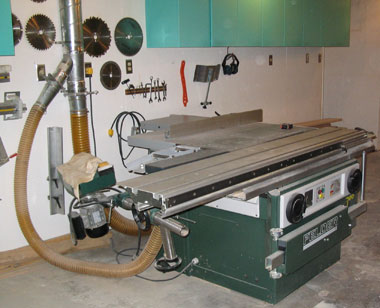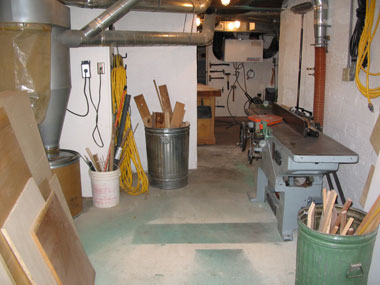What Woodworking Tools I Would Buy Now
Based
on my 30 Years Experience
by Bruce Lamo
Minneapolis,
Minnesota
 The old saying "If only I knew then what I know
now" certainly applies to buying
woodworking tools
. Like
nearly every woodworker, I would love a large shop equipped
with all the best tools. Like most woodworkers however, I
have had to make choices due to finances, space, and what
was available at the time of need. As I look back at the
purchases I made over the last 30 years, I have few true
regrets, but there are many things I would do differently.
Here is how I would approach equipment selection today.
The old saying "If only I knew then what I know
now" certainly applies to buying
woodworking tools
. Like
nearly every woodworker, I would love a large shop equipped
with all the best tools. Like most woodworkers however, I
have had to make choices due to finances, space, and what
was available at the time of need. As I look back at the
purchases I made over the last 30 years, I have few true
regrets, but there are many things I would do differently.
Here is how I would approach equipment selection today.
Hand Tools
Even though I have many large power
tools I am still a fan of hand tools, in particular, planes
and chisels. In many applications I have found they are the
fastest means to an end. Other factors in their favor are
their cost. Good hands tools are not cheap, but compared to
their motorized counterparts, they are usually much less
costly. Another is space. Besides taking up far less space
in the shop, they often require less space to use. Think of
edge joining an 8 foot long plank. On a jointer you need a
minimum of 16 feet of work space. With a hand plane, you
move the tool, not the material, so you only need slightly
more room than the length of the material.
The problem is that hand tools tend to require more
practice, and if you are looking to build that new piece of
furniture in fairly short order, time for extensive practice
to gain experience is in short supply. I won't argue with
the idea that machines are often a shortcut to results.
Power Tools
There is a seemingly endless
selection of power tools. Variations of tools that were only
seen in large cabinet shops and furniture factories can now
be found at the local big box hardware stores. Prices are
lower today than they have ever been in terms of real
dollars. Quality can vary and old brand names don't always
mean what they used to. So where do you start?
What's Typical
For almost any project, a few
basic requirements must be met. Wood needs to be cut to
size. Some joinery will take place, and the surface needs to
be prepped for finish. Hence, the most common sequence of
tool purchases might go something like this: An
inexpensive table saw, one or two hand planes, an orbital
sander, and a chisel or two. For many projects, that will
get you by.
As projects increase in size and scale, there is usually
a desire to get a larger table saw, a miter saw, add a small
jointer, a router and maybe a belt sander. Eventually,
things get out of hand and you are seen at every tool sale,
and spend more time online looking at the few remaining
tools for which you have not yet found a project that will
justify their purchase.
The Goal
Since money and space are usually in
high demand, you want your purchases to make sense and work
for you as far into the future as possible. To do this, the
focus should be how to expand your capabilities rather than
getting one project done quickly. With this in mind, and
based on what I've learned over the past three decades,
here's how I would proceed if I were starting over now.
First Steps
Hand Tools — Three to four hand
planes.
A low angle block plane, smoothing plane, jack plane
and a jointer plane
are the most used sizes. With these in
hand and some practice, you can go a long time without a
planer, jointer, belt sander, and a few other machines. The
market now has a few brands that are close to, if not ready,
to use off the shelf. I also think the purchase of at least
one good hand saw, a few good chisels, some clamps and a
card cabinet scraper are necessary for most projects.
Power Tools — A good
table saw
is usually the most used
machine in the shop. New saws have vastly improved fences
and better safety features. A good contractor saw has
adequate power and can come with up to 49" of ripping
capacity to handle sheet goods. This would be my first big
purchase. A
router
is often a highly coveted machine. There
are almost endless cutters available now and it is hard to
argue with their versatility. I recommend looking at the
combo packages that include a plunge base. It is a good way
to get two machines for the price of one. In my opinion, an
elaborate router table is not necessary for most
applications, nor are the expensive and bulky jigs and
templates for making joints. What tends to happen is the
tools start to drive what is made. Drawers start to fit the
machine or template instead of the piece of furniture.
Sufficient joints can be made with the table saw, by hand,
or you can make your own templates to fit your project.
These tools will enable you to build almost anything.
Remember, up until the mid-1800s, almost no power tools were
used. Furniture was largely made by hand. There are many
fine examples of that furniture still around today, so it is
safe to say that it wasn't the tools that made the craftsman
back then.
 Power Tools
Power Tools
As your experience grows,
it is typical to look for the next upgrade, which is often a
bigger tablesaw, a miter saw, a small jointer, or a small
planer. As I see it, if you own a decent contractor saw, a
bigger, heavier cabinet saw won't give you much more than
what you already have. The quality of cut will only be
marginally better. I would look to spend my money elsewhere.
A miter saw is a very useful machine, but their real
contribution is speed. The alternative to a miter saw is a
hand saw or the table saw. The table saw should deliver a
superior cut, but it normally takes longer for setup. You
need to decide what your time is worth.
A small jointer is better than no jointer, but a small
jointer is not a great addition to a shop.
A jointer needs
table length.
I would skip buying a small to medium size
jointer. Once again, rely on your hand tools. They can
perform as well or better than a machine that costs hundreds
more, they require a great deal of room, and they should be
run in conjunction with a dust collector. You can flatten
boards with a jack plane and straighten edges with a
jointer. With a little experience it becomes a quick task.
Small planers on the other hand can do a lot for you.
Here it is hard to argue with their capabilities. A large
industrial-weight planer is a machine few small shops can
justify, but there are numerous
portable planers
available
for a few hundred dollars that can deliver a reasonable cut.
They allow you to quickly clean up glue joints or prepare
rough lumber.
Another tool I have found almost indispensable is a
drill press
. Industrial grade machines are very heavy and too
expensive for most woodworkers, but a
small floor model
or
even a bench model will handle most woodworking needs
without too much trouble.
Another big machine many covet is a bandsaw. If you do
any resawing, they are a necessity. It is important that your bandsaw
be sturdy and powerful enough if you are resawing wide boards, and you will get much
better results if you choose a blade specifically designed for resawing, such as
Highland's famous
Wood Slicer
.
There are some who also swear by their bandsaw for
ripping lumber. A bandsaw can cut faster and is far safer to use
than a tablesaw. I personally still prefer to use a tablesaw for ripping
for two reasons. First, the bandsaw table and fence are
smaller than a typical tablesaw. I find this makes it harder for me
to keep a straight edge. Second is the quality of cut. A
bandsaw rip will usually be rougher than a tablesaw rip.
[Editor's note: While this statement may be generally true, most woodworkers who have
tried using a premium bandsaw blade like Highland's
Wood Slicer
for ripping and resawing have routinely achieved cuts with their bandsaw every bit as smooth as a tablesaw cut,
without sacrficing the increased speed and safety that a bandsaw provides.]
If your interest is in cutting curves, it is hard to beat the speed of
a bandsaw. If you do a lot of really intricate cutting, a scroll saw may come in handy.
Another option is the circular saw mated with a metal
guide (known as a
track saw
). These systems have quickly come into their own and
can deliver exceptional results. They are ideal for both
ripping and cross cutting sheets of plywood, but can handle
solid stock if it is wide enough. These systems can cost as
much as a table saw but they are compact and very portable.
 Dust Collection
Dust Collection
At some point dust
collection needs to be considered. For safety reasons all
power tools should run in conjunction with a good dust
collection system. However the reality is that many
woodworkers will put up with the dust for a while, if not
forever. There are machines that really can't be run without
dust collection such as a large planer or a bandsaw. The
chips and sawdust must be extracted or else the buildup will
damage the machine. A large shop vac may be sufficient for
smaller machines, and portable dust collectors are available
that can be moved from one machine to another.
Dust collection
is a reasonable investment
that should actually be made early on. Your health is well
worth the cost.
Bench top machines have come a long way with respect to
dust collection. Most now have ports that connect to a shop
vac. For a few dollars you can buy a switch that will
automatically power up the shop vac when you turn on the
tool (such as a sander). When you turn off the tool, the
switch will allow the shop vac to run a few extra seconds to
clear the hose and then shut off.
 Miscellaneous Bench Tools
Miscellaneous Bench Tools
The most
common bench tools in the woodshop are routers and sanders.
We have already talked about routers to some extent. Orbital
sanders have come a long way from the jitterbug style of
old. New sanders leave a better finish, are quieter and last
longer. At some point, probably right away, you will want a
sander
. No one likes to sand. It is tempting to buy multiple
sanders to address an unpleasant task. Here again, I point
to the hand tools. Learning to use a smoothing plane and a
cabinet scraper will reduce your sanding to little or
nothing and cut down your overall time to finish a project.
A belt sander can be a real workhorse if stock is in
rough shape. But good stock prep and careful joinery can
eliminate most uses for a belt sander. It is the least used
machine I have.
Other specialty tools such as a biscuit jointer or newer
versions of hand held joint making machines are handy and
can speed up joinery, but in my opinion fall far short of
being necessary.
Summary
Tools are purchased to expand our
capabilities and this will vary by the needs and goals of
the individual. Bigger, or more expensive machines are often
better as the machine goes, but before we make these
purchases, we should consider what is really needed for that
next project. Is it a machine, or is it skill? If the
machine is in lieu of learning a skill, is it really worth
it?
When it is time to make a purchase, is it better to
compromise and get an undersized machine that will only
improve our capabilities by a small degree? After 30 years
of working wood, my shop is equipped with several large,
heavy machines that I greatly enjoy having and using.
If I had to do it over, I personally would skip most of the
interim-sized machines that did not serve me well and I
would wait for the time when I could afford and have room
for the right machine. In the meantime, I could still be
productive with a smaller, but carefully selected group of
the right hand tools and power tools.


Useful Woodworking Tool List
Shop Woodworking Tools At HIghland Woodworking!
Bruce Lamo has done woodworking pretty much all his
life, although never exclusively to make a living. He
prefers making furniture and working with solid wood, but
often uses plywood when making cabinets. This article
originated when a few friends were considering buying tools
that based on his experience, he thought would not be a good
investment.